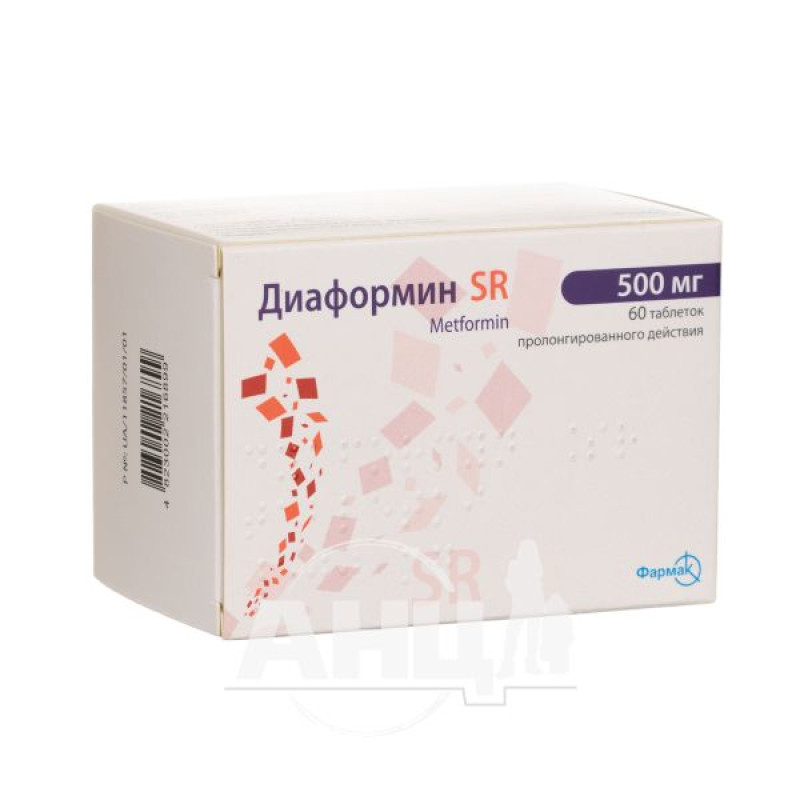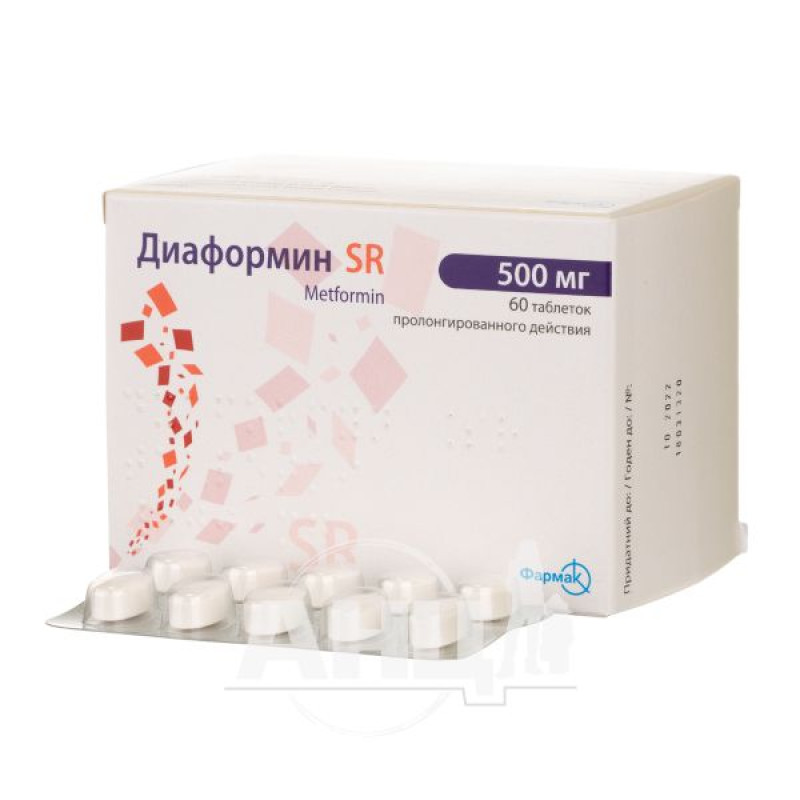Diaformin SR prolonged-release tablets 500 mg blister No. 60

Pharmacological properties
Pharmacodynamics. Metformin is a biguanide with antihyperglycemic effect. It reduces both the initial glucose level and the glucose level after a meal in the blood plasma. It does not stimulate insulin secretion and does not cause a hypoglycemic effect.
Metformin works in three ways:
leads to a decrease in glucose production in the liver by inhibiting gluconeogenesis and glycogenolysis; improves insulin sensitivity in muscles by improving peripheral glucose uptake and utilization; delays glucose absorption in the intestine.Metformin stimulates intracellular glycogen synthesis by acting on glycogen synthetase. Increases the transport capacity of all types of membrane glucose transporters (GLUT). Clinical studies have shown that the main effect of metformin is stabilization or a slight decrease in body weight.
Independently of its effect on glycaemia, metformin immediate-release tablets have a positive effect on lipid metabolism. This effect has been demonstrated at therapeutic doses in controlled medium- or long-term clinical trials: metformin immediate-release tablets reduce total cholesterol, low-density lipoproteins and triglycerides. A similar effect was not observed with the prolonged-release tablets, probably due to the evening administration of the drug. Therefore, an increase in TG may also be observed.
Pharmacokinetics. Absorption. After oral administration of Diaformin SR prolonged-release tablets, the absorption of metformin is significantly slower compared to metformin immediate-release tablets. The time to reach C max (Tmax) is 7 hours (Tmax for immediate-release tablets is 2.5 hours).
At steady state, as with the immediate-release tablets, Cmax and AUC increase disproportionately with the administered oral dose. The AUC after a single oral dose of 2000 mg metformin prolonged-release tablets is similar to the AUC observed after 1000 mg metformin immediate-release tablets twice daily.
The fluctuations in C max and AUC in individual subjects when taking metformin extended-release tablets are comparable to the fluctuations observed when taking metformin immediate-release tablets.
After taking the extended-release tablets on an empty stomach, a 30% decrease in AUC was noted (Cmax and Tmax remained unchanged).
The absorption of metformin from prolonged-release tablets is not affected by food. No accumulation is observed with multiple doses of up to 2000 mg of metformin prolonged-release tablets.
Distribution. Binding to plasma proteins is negligible. Metformin penetrates into erythrocytes. C max in blood is lower than C max in plasma and is reached after approximately the same time. Erythrocytes most likely represent a second distribution chamber. The mean volume of distribution (V d ) ranges from 63 to 276 l.
Metabolism: Metformin is excreted unchanged in the urine. No metabolites have been identified in humans.
Elimination. Renal clearance of metformin is 400 ml/min, indicating that metformin is eliminated by glomerular filtration and tubular secretion. After oral administration, T½ is approximately 6.5 hours. In renal impairment, renal clearance is reduced in proportion to creatinine clearance, and therefore T½ is increased, leading to increased metformin plasma levels.
Special patient groups. Renal impairment. There are limited data in patients with moderate renal impairment, so it is not possible to accurately estimate the systemic exposure of metformin in this patient group compared to patients with normal renal function. Therefore, dose adjustment is necessary according to clinical efficacy/tolerability (see Method of administration).
Indication
Type 2 diabetes mellitus (non-insulin-dependent) in adults (especially in overweight patients) when diet therapy and exercise are ineffective, as monotherapy or in combination with other oral antidiabetic agents or in combination with insulin.
Application
The tablets should be swallowed whole, without chewing.
Monotherapy or combination therapy in combination with other oral hypoglycemic agents. The recommended initial dose is 500 mg/day.
After 10-15 days of treatment, the dose should be adjusted according to the results of serum glucose measurements. A slow increase in dose helps to reduce gastrointestinal side effects. The maximum recommended dose is 2000 mg/day.
For patients already treated with metformin, the initial dose of Diaformin SR prolonged-release tablets should be equivalent to the daily dose of immediate-release tablets. It is not recommended to switch to Diaformin SR in patients receiving metformin therapy at a dose of 2000 mg/day.
When switching to Diaformin SR prolonged-release tablets, it is necessary to discontinue the other oral antidiabetic drug.
Combination therapy with insulin. To achieve better blood glucose control, metformin and insulin can be used as combination therapy. The usual starting dose of Diaformin SR is 500 mg/day with the evening meal, while the insulin dose should be adjusted according to blood glucose measurements.
Elderly patients may have decreased renal function, therefore the dose of metformin should be selected based on assessment of renal function, which should be performed regularly (see Precautions).
Patients with renal impairment. Metformin can be used in patients with moderate renal impairment, stage IIIA (creatinine clearance 45-59 ml/min or GFR 45-59 ml/min/1.73 m2), only in the absence of other conditions that may increase the risk of lactic acidosis, with subsequent dose adjustment: the initial dose is 500 mg or 750 mg of metformin hydrochloride 1 time per day. The maximum dose is 1000 mg/day. Careful monitoring of renal function (every 3-6 months) is necessary.
If creatinine clearance or GFR decreases to 5 ml/min or 45 ml/min/1.73 m2, respectively, metformin should be discontinued immediately.
Contraindication
- hypersensitivity to metformin or any other component of the drug;
diabetic ketoacidosis, diabetic precoma; moderate (stage IIIb) and severe renal failure or impaired renal function (creatinine clearance 45 ml/min or GFR 45 ml/min/1.73 m2); acute conditions with a risk of developing renal dysfunction, such as dehydration, severe infectious diseases, shock; diseases that can lead to the development of tissue hypoxia (especially acute diseases or exacerbation of a chronic disease): decompensated heart failure, respiratory failure, recent myocardial infarction, shock; liver failure, acute alcohol poisoning, alcoholism.Side effects
The most common adverse reactions, especially at the beginning of treatment, are nausea, vomiting, diarrhea, abdominal pain, and loss of appetite. These symptoms usually resolve on their own.
Metabolic and nutritional disorders: lactic acidosis (see Precautions).
With prolonged use of the drug in patients with megaloblastic anemia, the absorption of vitamin B12 may decrease, which is accompanied by a decrease in its level in the blood serum.
From the nervous system: taste disturbance.
Gastrointestinal: nausea, vomiting, diarrhea, abdominal pain, loss of appetite. Most often, these side effects occur at the beginning of treatment and, as a rule, disappear spontaneously. To prevent the occurrence of side effects from the gastrointestinal tract, a slow increase in the dose of the drug is recommended.
On the part of the hepatobiliary system: liver function tests or hepatitis, which completely disappear after metformin withdrawal.
Skin and subcutaneous tissue disorders: allergic skin reactions, including erythema, pruritus, urticaria.
Special instructions
Lactic acidosis is a rare but serious metabolic complication (high mortality rate in the absence of urgent treatment) that may occur as a result of metformin accumulation. Cases of lactic acidosis have been reported in diabetic patients with renal failure or a sharp deterioration in renal function. Caution should be exercised in cases where renal function may be impaired, for example, during dehydration (severe diarrhea or vomiting), or at the beginning of treatment with antihypertensive agents, diuretics and at the beginning of therapy with nonsteroidal anti-inflammatory drugs. In the event of these exacerbations, metformin should be temporarily discontinued.
Other risk factors should be considered to prevent the development of lactic acidosis: poorly controlled diabetes mellitus, ketosis, prolonged fasting, excessive alcohol consumption, hepatic insufficiency or any condition associated with hypoxia (decompensated heart failure, acute myocardial infarction) (see Adverse Reactions).
Diagnostics. Lactic acidosis is characterized by acidotic dyspnea, abdominal pain and hypothermia, and coma may develop later. Diagnostic indicators: laboratory decrease in blood pH, increase in serum lactate concentration of 5 mmol / l, increase in anion gap and lactate / pyruvate ratio. In case of development of lactic acidosis, the patient must be hospitalized immediately (see Conditions and shelf life). The doctor should warn patients about the risk of developing symptoms of lactic acidosis.
Renal failure. Since metformin is excreted by the kidneys, creatinine levels (estimated by plasma creatinine levels using the Cockcroft-Golta formula) or GFR should be checked before starting and regularly during treatment with Diaformin SR:
patients with normal renal function at least once a year; patients with creatinine clearance at the lower limit of normal and elderly patients at least 2-4 times a year.In the case of creatinine clearance of 45 ml/min (GFR 45 ml/min/1.73 m2), the use of metformin is contraindicated (see Side effects).
Decreased renal function is common in the elderly and may be asymptomatic. Caution should be exercised in situations where renal function may be compromised, such as dehydration, or at the start of treatment with antihypertensives, diuretics, or nonsteroidal anti-inflammatory drugs. In such cases, it is also recommended to check renal function before starting metformin.
Cardiac function. Patients with heart failure are at increased risk of hypoxia and renal failure. Metformin may be used in patients with stable chronic heart failure with regular monitoring of cardiac and renal function. Metformin is contraindicated in patients with acute and unstable heart failure (see Adverse Reactions).
Iodinated radiocontrast agents. Intravascular administration of radiocontrast agents for radiological examinations may lead to renal failure and, as a result, metformin accumulation and an increased risk of lactic acidosis. In patients with a GFR of 60 ml/min/1.73 m2, metformin should be discontinued prior to or at the time of the examination and not resumed until 48 hours after the examination, only after re-evaluation of renal function and confirmation of the absence of further deterioration of renal function (see Interactions with other medicinal products).
In patients with moderate renal impairment (GFR 45-60 ml/min/1.73 m2), metformin should be discontinued 48 hours before the administration of iodinated radiocontrast agents and not resumed earlier than 48 hours after the examination, only after re-evaluation of renal function and confirmation of the absence of further deterioration of renal function (see Interactions with other medicinal products).
Surgical interventions. Diaformin SR should be discontinued 48 hours before elective surgery performed under general, spinal or epidural anesthesia and not resumed earlier than 48 hours after surgery or resumption of oral nutrition and only if normal renal function has been established.
Other precautions. Patients should follow a diet with a balanced carbohydrate intake throughout the day. Overweight patients should continue to follow a low-calorie diet. Laboratory blood glucose levels should be monitored regularly.
Metformin monotherapy does not cause hypoglycemia. When Diaformin SR is used simultaneously with insulin or other oral hypoglycemic agents (e.g. sulfonylurea derivatives or meglitinides), an increase in the hypoglycemic effect is possible.
Fragments of the tablet shell may be present in the feces. This is normal and has no clinical significance.
Use during pregnancy and breastfeeding. Pregnancy. Uncontrolled diabetes during pregnancy (gestational or permanent) increases the risk of congenital anomalies and perinatal mortality. There are limited data on the use of metformin in pregnant women, which do not indicate an increased risk of congenital anomalies. Preclinical studies have not revealed any negative effects on pregnancy, embryonal or fetal development, childbirth and postnatal development. In case of planning pregnancy, as well as its onset, metformin therapy should be discontinued, the doctor should be informed and insulin therapy should be prescribed to maintain blood glucose levels as close to normal as possible to reduce the risk of fetal malformations.
Breastfeeding. Metformin is excreted in human milk, but no adverse effects have been observed in breastfed newborns/infants. However, due to insufficient data on the safety of the drug, breastfeeding is not recommended during therapy with Diaformin SR. The decision to discontinue breastfeeding should be made taking into account the benefits of breastfeeding and the potential risk of adverse effects for the child.
Fertility: Metformin had no effect on animal fertility at doses of 600 mg/kg/day, which is almost three times the maximum recommended daily human dose based on body surface area.
Ability to influence the reaction rate when driving vehicles or operating other mechanisms. Diaformin SR does not affect the reaction rate when driving vehicles or operating other mechanisms, since monotherapy with the drug does not cause hypoglycemia.
However, caution should be exercised when metformin is used in combination with other hypoglycemic agents (sulfonylureas, insulin, meglitinides) due to the risk of hypoglycemia.
Interactions
Combinations that are not recommended for use
Alcohol. Acute alcohol intoxication is associated with an increased risk of lactic acidosis, especially in cases of fasting or low-calorie diet, as well as in liver failure. When treating with Diaformin SR, ethanol and ethanol-containing drugs should be avoided.
Iodinated radiopaque agents: Intravascular administration of iodinated contrast agents may lead to functional renal failure and metformin accumulation and increase the risk of lactic acidosis.
In patients with a GFR of 60 ml/min/1.73 m2, metformin should be discontinued prior to or at the time of the test and not resumed until 48 hours after the test, only after re-evaluation of renal function and confirmation of no further deterioration of renal function (see SPECIAL PRECAUTIONS).
In patients with moderate renal impairment (GFR 45-60 ml/min/1.73 m2), metformin should be discontinued 48 hours before the administration of iodinated radiocontrast agents and not resumed earlier than 48 hours after the examination, only after re-evaluation of renal function and confirmation of the absence of further deterioration of renal condition.
Combinations to be used with caution
Drugs that have a hyperglycemic effect (systemic and local corticosteroids, sympathomimetics, chlorpromazine). It is necessary to monitor blood glucose levels more often, especially at the beginning of treatment. During and after discontinuation of such combined therapy, it is necessary to adjust the dose of Diaformin SR under the control of glycemia.
ACE inhibitors may lower blood glucose levels. If necessary, the dose of the drug should be adjusted during combination therapy.
Diuretics, especially loop diuretics, may increase the risk of lactic acidosis due to possible decreased renal function.
Overdose
When using the drug at a dose of 85 g, hypoglycemia was not observed, but the occurrence of lactic acidosis was noted. A significant excess of the metformin dose or concomitant risk factors can lead to the occurrence of lactic acidosis. Lactic acidosis is an emergency. In the event of lactic acidosis, treatment with Diaformin SR must be discontinued and the patient urgently hospitalized.
The most effective measure for removing lactate and metformin from the body is hemodialysis.
Storage conditions
At a temperature not exceeding 30 °C.
There are no reviews for this product.
There are no reviews for this product, be the first to leave your review.
No questions about this product, be the first and ask your question.




